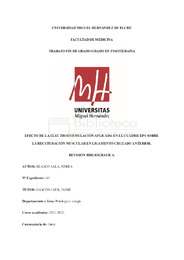Por favor, use este identificador para citar o enlazar este ítem:
https://hdl.handle.net/11000/28282Registro completo de metadatos
| Campo DC | Valor | Lengua/Idioma |
|---|---|---|
| dc.contributor.advisor | Gascón Jaén, Jaime | - |
| dc.contributor.author | Blasco Sala, Nerea | - |
| dc.contributor.other | Departamentos de la UMH::Patología y Cirugía | es_ES |
| dc.date.accessioned | 2022-11-08T09:06:50Z | - |
| dc.date.available | 2022-11-08T09:06:50Z | - |
| dc.date.created | 2022-06-20 | - |
| dc.identifier.uri | https://hdl.handle.net/11000/28282 | - |
| dc.description.abstract | Introducción: la ruptura del ligamento cruzado anterior es una de las lesiones más frecuentes en deportistas, asociada a cambios de dirección, maniobras de salto y acciones de deceleración. La rehabilitación tras la reconstrucción se centra en restaurar el rango articular, recuperar fuerza muscular, proteger el injerto… Cabe destacar la atrofia del cuádriceps como elemento clave, donde la aplicación de la electroestimulación puede llegar a ser una intervención clave. Objetivos: evaluar el efecto de la electroestimulación sobre el cuádriceps tras la ruptura de LCA, determinar los métodos de aplicación más apropiados y comparar frente a otros tipos de tratamiento. Material y métodos: se realizó una búsqueda de ensayos clínicos publicados a partir del año 2000 en las bases de datos PubMed, PEDro y Scopus, que determinaran la efectividad de la electroestimulación aplicada sobre el cuádriceps. Resultados: se obtuvieron 14 estudios, 8 compararon la aplicación de la electroestimulación frente a un grupo control observando su efectividad. Otros 3 realizaron una comparación entre diferentes modalidades y los restantes la compararon frente a otros tipos de tratamiento. La principal medida de resultado que se analizó fue la contracción isométrica máxima voluntaria del cuádriceps, algunos estudios incluyeron también la simetría de carga, el rango articular y la funcionalidad del miembro inferior. Conclusión: existe evidencia limitada de que la electroestimulación presenta efectos positivos para recuperar la fuerza muscular del cuádriceps, de otro modo no existe evidencia suficiente para determinar qué tipo y qué parámetros de electroestimulación son los más efectivos, así como tampoco que tenga mejores resultados frente a otras técnicas de tratamiento. | es_ES |
| dc.description.abstract | Introduction: Anterior cruciate ligament rupture is one of the most common injuries seen in athletes, usually associated with changes in direction, jumps and deceleration actions. Rehabilitation after reconstruction focuses on restoring the joint range, regaining muscle strength, protecting the graft… Quadriceps atrophy is observed as a key element, where the application of electrostimulation can become an important intervention. Objectives: Evaluate the effect of electrostimulation on the quadriceps after ACL rupture, determine the most appropriate application methods and compare against other types of treatment. Material and methods: a search was made for clinical trials published since 2000 in the PubMed, PEDro and Scopus databases, which will try to determine the effectiveness of electrostimulation applied on the quadriceps for patients with this knee pathology. Results: 14 studies were obtained, 8 compared the application of electrostimulation against a control group to observe its effectiveness. Another 3 realized a comparison between different modalities and parameters of electrostimulation, trying to determine the most suitable. Finally, the other studies compared electrostimulation to other types of treatment. The main outcome measure that was analyzed was the voluntary maximum isometric contraction of the quadriceps, furthermore other studies included load symmetry, joint range and lower limb functionality. Conclusion: there is moderate evidence that electrostimulation has positive effects to recover quadriceps muscle strength, otherwise there isn't enough evidence to determine which type and which electro stimulation parameters are most effective. In addition, it cannot be evidenced that it has better results compared to other treatment techniques. | es_ES |
| dc.format | application/pdf | es_ES |
| dc.format.extent | 38 | es_ES |
| dc.language.iso | spa | es_ES |
| dc.publisher | Universidad Miguel Hernández | es_ES |
| dc.rights | info:eu-repo/semantics/openAccess | es_ES |
| dc.rights | Attribution-NonCommercial-NoDerivatives 4.0 Internacional | * |
| dc.rights.uri | http://creativecommons.org/licenses/by-nc-nd/4.0/ | * |
| dc.subject | Fisioterapia | es_ES |
| dc.subject | Ligamento cruzado anterior | es_ES |
| dc.subject | Electroestimulación | es_ES |
| dc.subject | Cuádriceps | es_ES |
| dc.subject.other | CDU::6 - Ciencias aplicadas | es_ES |
| dc.title | Efecto de la electroestimulación aplicada en el cuádriceps sobre la recuperación muscular en ligamento cruzado anterior. Revisión bibliográfica | es_ES |
| dc.type | info:eu-repo/semantics/bachelorThesis | es_ES |

Ver/Abrir:
TFG Blasco Sala, Nerea.pdf
1,21 MB
Adobe PDF
Compartir:
 La licencia se describe como: Atribución-NonComercial-NoDerivada 4.0 Internacional.
La licencia se describe como: Atribución-NonComercial-NoDerivada 4.0 Internacional.
.png)